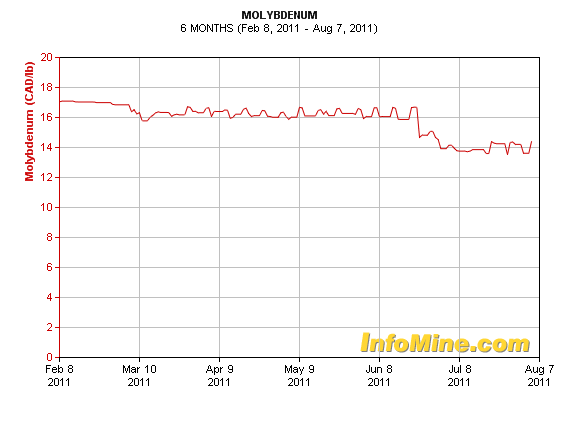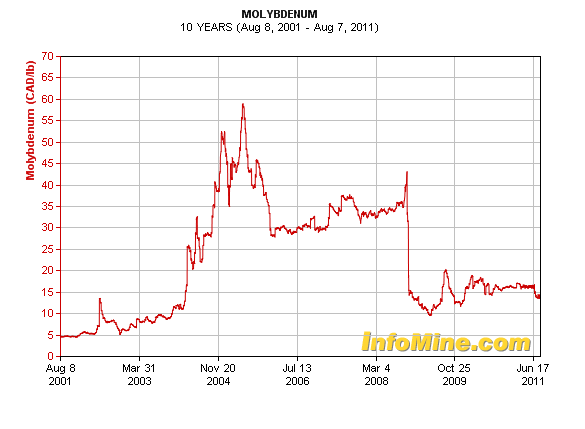Molybdenum Prices & Information on Molybdenum Investing
By mitch · November 2, 2010 · 4:04 pm · Leave a Comment


Molybdenum
Molybdenum is a Group 6 chemical element with the symbol Mo and atomic number 42. The name is from Neo-Latin Molybdaenum, from Ancient Greek Μόλυβδος molybdos, meaning lead, since its ores were confused with lead ores. The free element, which is a silvery metal, has the sixth-highest melting point of any element. It readily forms hard, stable carbides, and for this reason it is often used in high-strength steel alloys. Molybdenum does not occur as the free metal in nature, but rather in various oxidation states in minerals. Industrially, molybdenum compounds are used in high pressure and high temperature applications, as pigments and catalysts.
Molybdenum minerals have long been known, but the element was "discovered" (in the sense of differentiating it as a new entity from minerals salts of other metals) in 1778 by Carl Wilhelm Scheele. The metal was first isolated in 1781 by Peter Jacob Hjelm.
Most molybdenum compounds have low solubility in water, but the molybdate ion MoO42- is soluble and will form if molybdenum-containing minerals are in contact with oxygen and water. Recent theories suggest that the release of oxygen by early life was important in removing molybdenum from minerals into a soluble form in the early oceans, where it was used as a catalyst by single-celled organisms. This sequence may have been important in the history of life, because molybdenum-containing enzymes then became the most important catalysts used by some bacteria to break the chemical bond in atmospheric molecular nitrogen, allowing biological nitrogen fixation. This, in turn allowed biologically driven nitrogen-fertilization of the oceans, and thus the development of more complex organisms.
At least 50 molybdenum-containing enzymes are now known in bacteria and animals, though only the bacterial and cyanobacterial enzymes are involved in nitrogen fixation. Due to the diverse functions of the remainder of the enzymes, molybdenum is a required element for life in higher organisms (eukaryotes), though not in all bacteria.
Characteristics
In its pure form, molybdenum is silvery white metal with a Mohs hardness of 5.5. It has a melting point of 2,623 °C (4,753 °F); of the naturally occurring elements, only tantalum, osmium, rhenium, tungsten and carbon have higher melting points. Molybdenum burns only at temperatures above 600 °C (1,112 °F). It has one of the lowest coefficient of thermal expansion among commercially used metals. Tensile strength of molybdenum wires increases about 3 times from about 10 to 30 GPa when their diameter decreases from ~50-100 nm to 10 nm.
As also noted below, the most common isotopic molybdenum application involves molybdenum-99, which is a fission product. It is a parent radioisotope to the short-lived gamma-emitting daughter radioisotope technetium-99m, a nuclear isomer which is used in various imaging applications in medicine.
History
Molybdenite-the principal ore from which molybdenum is now extracted-was previously known as molybdena. Molybdena was confused with and often implemented as though it were graphite. Even when molybdena was distinguishable from graphite, it was still confused with a common lead ore (now called galena), which took its name from Ancient Greek Μόλυβδος molybdos, meaning lead In 1754, Bengt Andersson Qvist examined molybdenite and determined that it did not contain lead and was thus not the same as galena.
It was not until 1778 that Swedish chemist Carl Wilhelm Scheele realized molybdena was neither graphite nor lead. He and other chemists then correctly assumed that it was the ore of a distinct new element, named molybdenum for the mineral in which it was discovered. Peter Jacob Hjelm successfully isolated molybdenum using carbon and linseed oil in 1781.
For a long time there was no industrial use for molybdenum. Although apparent deliberate alloying of molybdenum with steel in one 14th century Japanese sword has been reported, that art was never employed widely, and later lost. Upon its rediscovery, the French Schneider Electric company produced the first molybdenum-steel armor plates in 1894. Until World War I, most other armor factories also used molybdenum alloys. In World War I, some British tanks were protected by 75 mm (3 in) manganese steel plating, but this proved to be ineffective. The manganese steel plates were then replaced with 25 mm (1 in) molybdenum-steel plating. These allowed for higher speed, greater maneuverability, and, despite being thinner, better protection. The high demand for molybdenum in World War I and World War II and the steep decrease after the wars had a great influence on prices and production of molybdenum.
Occurrence
Molybdenum output in 2005
Molybdenite on quartz
The world’s largest producers of molybdenum materials are the United States, China, Chile, Peru and Canada.Though molybdenum is found in such minerals as wulfenite (PbMoO4) and powellite (CaMoO4), the main commercial source of molybdenum is molybdenite (MoS2). Molybdenum is mined as a principal ore, and is also recovered as a byproduct of copper and tungsten mining. Large mines in Colorado (such as the Henderson mine and the now-inactive Climax mine) and in British Columbia yield molybdenite as their primary product, while many porphyry copper deposits such as the Bingham Canyon Mine in Utah and the Chuquicamata mine in northern Chile produce molybdenum as a byproduct of copper mining. The Knaben mine in southern Norway was opened in 1885, making it the first molybdenum mine. It remained open until 1973.
Molybdenum is the 54th most abundant element in the Earth's crust and the 25th most abundant element in the oceans, with an average of 10 parts per billion; it is the 42nd most abundant element in the Universe. The Russian Luna 24 mission discovered a molybdenum-bearing grain (1 × 0.6 µm) in a pyroxene fragment taken from Mare Crisium on the Moon.
Production
The molybdenite is first heated to a temperature of 700 °C (1,292 °F) and the sulfide is oxidized into molybdenum(VI) oxide by air:
- 2 MoS2 + 7 O2 → 2 MoO3 + 4 SO2
The oxidized ore is then either heated to 1,100 °C (2,010 °F) to sublimate the oxide, or leached with ammonia which reacts with the molybdenum(VI) oxide to form water-soluble molybdates:
- MoO3 + 2 NH4OH → (NH4)2(MoO4) + H2O
Copper, an impurity in molybdenite, is less soluble in ammonia. To completely remove it from the solution, it is precipitated with hydrogen sulphide.
Pure molybdenum is produced by reduction of the oxide with hydrogen, while the molybdenum for steel production is reduced by the aluminothermic reaction with addition of iron to produce ferromolybdenum. A common form of ferromolybdenum contains 60% molybdenum.
Molybdenum has a value of approximately $30,000 per tonne as of August 2009. It maintained a price at or near $10,000 per tonne from 1997 through 2003, and reached, due to increased demand, a peak of $103,000 per tonne in June 2005. In 2008 the London Metal Exchange announced that molybdenum would be traded as a commodity on the exchange.
Applications

MoSi2 heating element
The ability of molybdenum to withstand extreme temperatures without significantly expanding or softening makes it useful in applications that involve intense heat, including the manufacture of aircraft parts, electrical contacts, industrial motors and filaments.
Most high-strength steel alloys (example 41xx steels) contain 0.25% to 8% molybdenum. Despite such small portions, more than 43,000 tonnes of molybdenum are used as an alloying agent each year in stainless steels, tool steels, cast irons and high-temperature superalloys.
Because of its lower density and more stable price, molybdenum is sometimes used instead of tungsten. An example is the 'M' series of high-speed steels such as M2, M4 and M42 as substitution for the 'T' steel series which contain tungsten. Molybdenum can be implemented both as an alloying agent and as a flame-resistant coating for other metals. Although its melting point is 2,623 °C (4,753 °F), molybdenum rapidly oxidizes at temperatures above 760 °C (1,400 °F) making it better-suited for use in vacuum environments.
TZM (Mo (-99%), Ti (-0.5%), Zr (-0.08%) and some C) is a corrosion resisting molybdenum superalloy that resists molten fluoride salts at temperatures above 1300C. It has about twice the strength of pure Mo, and is more ductile and more weldable, yet in tests it resisted corrosion of a standard eutectic salt (FLiBe) and salt vapors used in molten salt reactors for 1100 hours with so little corrosion that it was difficult to measure.
Other molybdenum-based alloys which do not contain iron have only limited applications. For example, because of the corrosion resistance against molten zinc, both pure molybdenum and the molybdenum/tungsten alloy (70%/30%) are used for piping, stirrers and pump impellers which come into contact with molten zinc.
- Molybdenum-99 is a parent radioisotope to the daughter radioisotope technetium-99m, which is used in many medical procedures.
- Molybdenum disulfide (MoS2) is used as a solid lubricant and a high-pressure high-temperature (HPHT) antiwear agent. It forms strong films on metallic surfaces and is a common additive to HPHT greases—in case of a catastrophic grease failure, thin layer of molybdenum prevents contact of the lubricated parts.
- Molybdenum disilicide (MoSi2) is an electrically conducting ceramic with primary use in heating elements operating at temperatures above 1500 °C in air.
- Molybdenum trioxide (MoO3) is used as an adhesive between enamels and metals. Lead molybdate (wulfenite) co-precipitated with lead chromate and lead sulfate is a bright-orange pigment used with ceramics and plastics.
- Molybdenum powder is used as a fertilizer for some plants, such as cauliflower.
- The element is also used in NO, NO2, NOx analyzers in power plants for pollution controls. At 350 °C (662 °F) the element acts as a catalyst for NO2/NOx to form only NO molecules for consistent readings by infrared light.
- Ammonium heptamolybdate is used in biological staining procedures.